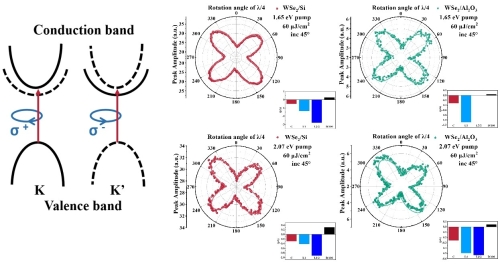In cooperation with the Hangzhou Institute for Advanced Study, University of Chinese Academy of Sciences (UCAS), the Aerospace Information Research Institute, Chinese Academy of Sciences (CAS), the State Key Laboratory of High-field Laser Physics of the Shanghai Institute of Optics and Fine Mechanics, Chinese Academy of Sciences (CAS) made progress in the study of transient current terahertz emission dynamics and valley degree of freedom detection in WSe2-Si hybrid dimensional heterostructures recently. The corresponding work was published in Journal of Physical Chemistry Letters titled “Ultrafast Drift Current Terahertz Emission Amplification in the Monolayer WSe2/Si Heterostructure” on December 2, 2022.
Van der Waals heterostructures based on monolayer transition metal chalcogenides (TMDs), as two-dimensional semiconductors with multiple photoelectric properties such as strong spin momentum locking, layer-dependent tunable electronic energy band have important application potential in on-chip integrated light sources, new photoelectric detector and valleytronics technology. In this work, the non-contact ultrafast terahertz emission spectroscopy was first used to detect the transient photocurrent amplified by depletion field in TMDs-Si heterostructures, and the valley degree of freedom was detected and all-optical manipulated. This work provides a new route for exploring valleytronics based on 2D-3D hybrid dimensional heterostructures.
In this work, time-resolved terahertz emission spectroscopy was used to investigate the ultrafast terahertz emission dynamics of monolayer WSe2-Si heterostructure pumped by femtosecond laser. It is found that the enhanced depletion field in the WSe2-Si heterostructure accelerates the carrier migration, resulting in an amplified transient current and the corresponding 10 times larger terahertz emission.
Meanwhile, the valley-polarized photocurrent in the WSe2-Si heterostructure which depends on the chirality of the pump light was also demonstrated at room temperature. These findings confirmed the existence of the spin momentum locking effect in the hybrid-dimensional heterostructures. Additionally, it is also found that the chirality of valley momentum-locked photocurrent in monolayer WSe2 could be reserved in the heterostructure. Therefore, the polarization dependence of valley current can also be used to effectively tune the terahertz emission of semiconductor materials.
The method of terahertz emission amplification in silicon-based 2D-3D material heterostructures expands the way to improve the efficiency of terahertz emitter, which is of great significance for the research of new Journal of Physical Chemistry Letters integrated terahertz chips. In addition, the non-contact detection of valley photocurrent in TMDs by ultrafast terahertz emission spectroscopy at room temperature broadens the path of detecting spin momentum locking effect and provides a new idea for the research of valleytronics based on such structure.

Figure 1: (a) Schematic of terahertz emission spectroscopy; (b) Time domain THz emission waveforms; (c) Schematic of terahertz emission from depletion current in the heterostructure. (Image by SIOM)

Figure 2: (a) Schematic of optical selection rules in WSe2;(b) Chiral dependence of pump light in monolayer WSe2 and WSe2-Si heterostructure. (Image by SIOM)
Contact:
WU Xiufeng
General Administrative Office
Shanghai Institute of Optics and Fine Mechanics, CAS
Email: xfwu@siom.ac.cn
Web: http://english.siom.cas.cn/
Home | About SIOM | Newsroom | International | Admissions | Publications | Contact
@ Shanghai Institute of Optics and Fine Mechanics Tel:02169918000 沪ICP备05015387号-1 Technical support:Qingyun Software